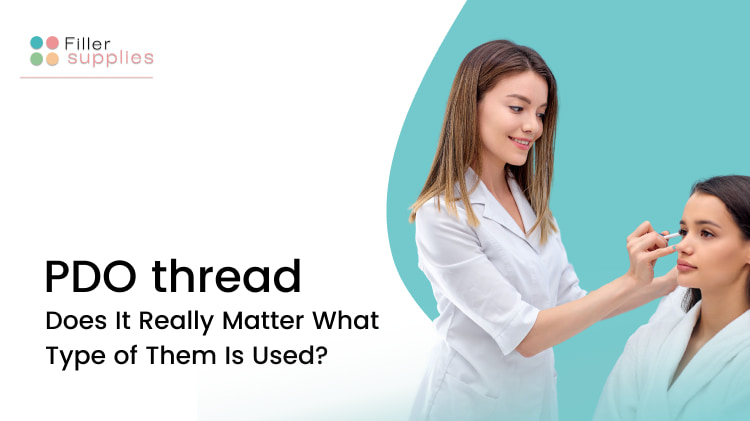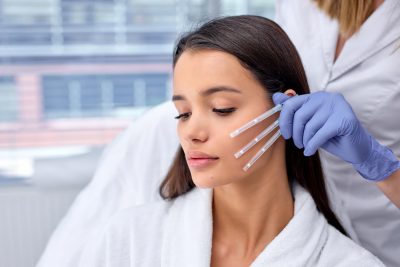Does It Really Matter What Kind of PDO Thread Is Used?

Do you know what type of facial lifting is minimally invasive but at the same time extremely efficient? It is definitely a PDO thread lift that enumerates such benefits as minimal to no downtime, natural-looking result, and extreme safety.
Moreover, there is a couple of different PDO thread lift types, each of them having their own peculiarities, benefits, and drawbacks. But is there any difference when it comes to what kind of threads is preferable to use? Let’s figure it out together!
A side note: If you would like to try PDO threads or other procedures of aesthetic medicine (as, for example, synergistic skin lifting treatments), check out the assortment of FillerSupplies, a certified reseller of original products with worldwide delivery.
What Is a PDO Thread Aesthetic Treatment?
Above anything else, let us check out what is the PDO thread aesthetic therapy. In simple words, it is a cosmetic procedure that involves the usage of thin and dissolvable polydioxanone sutures for a number of aesthetic reasons, such as:
- Floppy skin lifting;
- Skin texture improvement;
- Fat tissue contraction;
- Overall skin rejuvenation;
- Etc.
Therefore, it is considered to be a non-surgical form of facial lifting that is used to lift sagging skin (that could have appeared because of the natural aging process) and help you acquire a more youthful appearance.
The working principle of a PDO thread treatment is quite straightforward. After a health care practitioner has injected a PDO thread into your skin, muscles, or subcutaneous tissue, it starts acting in the following way:
- It relaxes muscles;
- It improves the blood flow;
- It stimulates natural collagen production.
As a result, you get a tightened, lifted, and enhanced skin texture. Moreover, fewer fine lines will be visible immediately after the insertion of the threads.
A side note: A PDO thread lifting is considered to be a safe procedure and is approved by FDA. Moreover, it requires minimal to no downtime and you can get back to your everyday activity right after the procedure.
While a PDO thread lift might be used to treat both face and neck, they are usually applied to lift and tighten such areas as:
- Brows;
- Nasolabial area;
- Forehead;
- Cheeks;
- Jaw-line;
- Chin;
- Etc.
After the PDO thread treatment, you might expect to receive instant skin lifting on the one hand and gradual improvement of the overall skin condition on the other hand. The maximum result will become visible within the time period of six months and might last up to two years.
A side note: A PDO thread is dissolvable and will disappear within twelve weeks after the treatment.
Despite the fact that PDO threads are considered to be safe, you might still experience the following side effects after the procedure:
- Pain, redness, or irritation of the treatment site;
- Bruising;
- Inflammation;
- Etc.
As well, a procedure might lead to allergic reactions in some cases.
A side note: Despite the fact that a PDO thread lift is considered to be a new treatment when it comes to aesthetic medicine, it has already been applied in general medicine for a couple of decades. Namely, such health issues as gynecological disorders have been treated by sutures before they started to be used for cosmetic reasons.
What Are the Main Types of PDO Threads?
There are three main types of PDO threads available on the aesthetic medicine market nowadays. Namely, you might come across mono, cog threads, and screw threads.
But what is the difference between them? Let’s figure it out by having a closer look at each of them:
- Mono threads are characterized by a smooth structure without any barbs and are applied to the neck, forehead, and under eyes areas. Moreover, these smooth PDO threads usually serve as an anchoring point of the face, tighten the skin, and have the power to lift it up slightly;
- Cog threads, contrary to the non-barbed threads, have barbs that are supposed to hook onto the skin. These barbed threads are namely used to support and lift up the floppy skin tissue;
- Screw threads, in their turn, consist of one or two intertwined threads. Therefore, it provides a solid volume restoration of the sunken skin and is used for general face lifting.
Another widely spread classification of PDO threads divides them into non-barbed and barbed ones. While the non-barbed sutures, in their turn, are subdivided into braided and mono threads, and the barbed ones – into unilateral, bilateral, spiral, Z-type, and many more.
A side note: Please keep in mind that, depending on your personal skin condition, your health care practitioner will be able not only to pick up the most suitable PDO thread for you but also cut off the excess threads if needed.
On top of that, different threads have various shapes, lengths, and thicknesses. Therefore, while one thread type might be suitable for thin skin, another one might be ideal for a neck lift.
If you are looking for useful information, then you should visit our article Facial Enhancement with PDO Mono Threads. It will help you understand all the subtleties and nuances of the procedure.
Does a Type of a PDO Thread Matter?
So, does a type of a PDO thread really matter? And is there any difference when it comes to what facial and neck areas should a certain PDO thread lift treat? Well, due to the fact that there is a distinct difference between mono, cod, and screw threads (while each type has its own peculiarities and is used for various purposes), the kind of thread that should be used in your particular case really matters.
Moreover, the effectiveness of PDO thread lift procedures directly depends on a carefully and properly selected thread type. For instance, the usage of a mono thread type might be enough in case you have slightly floppy skin. However, you might require to use a screw thread type if your skin needs a more substantial lifting. Besides, you might either need or do not need barbed threads for instant skin tightening and fine lines reduction.
A side note: Please keep in mind that each particular type of PDO suture has its own unique purpose. Therefore, it should be chosen individually in regard to the condition of your skin and the result you would like to achieve.
A Bottom Line
All in all, a PDO thread lift is a safe anti-aging treatment and an efficient way of facial rejuvenation. While there are three main types of PDO threads (namely, mono, cog, and screw), results from a PDO thread lift depend on a correctly chosen kind of sutures. So, how about consulting with your health care practitioner right away, trying out a PDO thread lift yourself, and, thus, benefiting from tight and rejuvenated skin?

